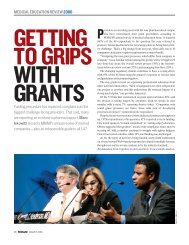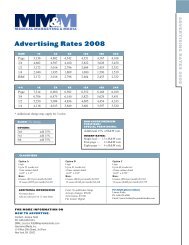Essential Guide to E-mail Marketing - Haymarket
Essential Guide to E-mail Marketing - Haymarket
Essential Guide to E-mail Marketing - Haymarket
You also want an ePaper? Increase the reach of your titles
YUMPU automatically turns print PDFs into web optimized ePapers that Google loves.
44 E-MAIL CAMPAIGNS DM News • E-Mail <strong>Marketing</strong> <strong>Guide</strong> 2007<br />
According <strong>to</strong> a Jupiter<br />
Communications survey, 80 percent<br />
of online companies say they<br />
do some form of viral promoting.<br />
A study from Sharpe Partners<br />
revealed that nearly 9 of 10 adult<br />
Internet users in the US share<br />
content with others via e-<strong>mail</strong>.<br />
Eighty-one percent pass viral messages<br />
on <strong>to</strong> at least one other person;<br />
almost half are likely <strong>to</strong> pass<br />
Josh Perlstein<br />
that message along <strong>to</strong> two or<br />
Response Media<br />
three other people.<br />
A 2007 <strong>Marketing</strong>Sherpa study points <strong>to</strong> the “experience<br />
chasm” that gives a significant edge <strong>to</strong> experienced viral marketers.<br />
Response Media has tested numerous viral programs for<br />
consumer packaged goods firms, so here are some tips for delivering<br />
value beyond simple “buzz”:<br />
■ Use viral as a stepping s<strong>to</strong>ne <strong>to</strong> build relationships and grow<br />
brand affinity Whether building prospect databases or driving<br />
online sales, understanding which sites and which people have the<br />
greatest probability of spreading a message is the key <strong>to</strong> getting<br />
something <strong>to</strong> spread.<br />
■ Viral works best when integrated in<strong>to</strong> your overall marketing<br />
mix Viral is not a standalone technique. It needs <strong>to</strong> be used strategically<br />
as a means <strong>to</strong> an end.<br />
■ Get real Marketers model the viral market opportunity <strong>to</strong> set<br />
goals, performance metrics and realistic budgets. Developing<br />
behavioral and motivational profiles is far better than banking on<br />
a single creative approach applied across different strategies.<br />
Analysis of behavioral models and multiple cycles of multivariate<br />
testing will allow you <strong>to</strong> turn your viral marketing in<strong>to</strong> a predictable,<br />
measureable marketing channel.<br />
■ Allow recipients <strong>to</strong> download the content in a useable form<br />
These include JPG pictures, MPG videos, etc. Viral marketing<br />
succeeds when you have a <strong>to</strong>pic that motivates cus<strong>to</strong>mers <strong>to</strong> talk<br />
and you help them share that conversation.<br />
Provide an interactive Web site dedicated <strong>to</strong> creating a strong<br />
online community. Experienced companies also reach out <strong>to</strong> cus<strong>to</strong>mers<br />
and prospects by putting a special offer in an e-<strong>mail</strong>, which<br />
becomes an easy-<strong>to</strong>-forward means of building buzz.<br />
■ Measure and analyze pass-along, click-through and conversion<br />
rates. Separate the click-through and conversion rates by original<br />
cus<strong>to</strong>mers from referrals and evaluate their respective performances<br />
in addition <strong>to</strong> tracking which people actually purchased something<br />
from your business.<br />
■ Follow hygiene, suppression and other data management best<br />
practices. From ensuring that the code blocks multiple submissions<br />
of the form by same session/IP address in a short time span,<br />
<strong>to</strong> checks for obscene content, the form and function of viral campaigns<br />
need <strong>to</strong> be thought through from the outset.<br />
Creatively integrating the viral program in<strong>to</strong> your overall marketing<br />
mix, setting realistic goals, and testing and optimizing will<br />
help drive rapid, positive exposure through trusted word-of-mouth<br />
networks for minimal cost.<br />
Josh Perlstein is president of Response Media. He can be reached at<br />
joshp@responsemedia.com.<br />
ESSENTIAL GUIDE<br />
Design for your<br />
eight e-<strong>mail</strong> audiences<br />
BY STEFAN POLLARD<br />
As a marketer, you might send one identical message per campaign<br />
<strong>to</strong> a highly targeted list of active recipients, but it will still<br />
be seen by eight different e-<strong>mail</strong> audiences, each of whom reads and<br />
responds <strong>to</strong> your message in a different way. So it’s vital <strong>to</strong> find a<br />
design that appeals <strong>to</strong> as many of those audiences as possible.<br />
Just <strong>to</strong> complicate matters, the audiences can shift each time.<br />
The same recipients might read your message differently from edition<br />
<strong>to</strong> edition, depending on their mood or time constraints.<br />
Understanding the major e-<strong>mail</strong> audiences will help you choose<br />
the right design tactics <strong>to</strong> maximize the likelihood that everyone<br />
will read and comprehend your message.<br />
The eight different audiences are:<br />
■ Identifiers Identifiers have one goal: They use the “from”<br />
address and the subject line <strong>to</strong> whittle down their inboxes as fast<br />
as possible, deleting everything they don’t want. Clear branding<br />
and great subject lines have the greatest impact.<br />
■ HTML vs. text Some e-<strong>mail</strong> clients give users a choice between<br />
HTML or text, which is why multipart MIME format has two<br />
parts: HTML for those who prefer e-<strong>mail</strong>s with images and text<br />
for those who don’t. Every e-<strong>mail</strong> you send should include both<br />
versions even if your preference center doesn’t capture this choice.<br />
■ Skimmers vs. readers Skimmers open your message, but they<br />
want <strong>to</strong> read as fast as possible, using headlines, subheads and<br />
CTAs as cues. When you craft your message, have all these copy<br />
points working in unison <strong>to</strong> deliver the idea and lead <strong>to</strong> the clickthrough.<br />
Readers want <strong>to</strong> read<br />
the two-<strong>to</strong>-three sentences of<br />
body copy between the headline<br />
and CTA <strong>to</strong> “learn more” about<br />
the specific <strong>to</strong>pic the e-<strong>mail</strong> is discussing<br />
and help them over the<br />
click-through hurdle.<br />
■ Mobile vs. desk Some PDAs<br />
display HTML just fine. Others<br />
show a text version including<br />
lines of ugly HTML code. These<br />
e-<strong>mail</strong> addicts will most likely<br />
Stefan Pollard<br />
save your message <strong>to</strong> read later<br />
E<strong>mail</strong>Labs<br />
on a desk<strong>to</strong>p or lap<strong>to</strong>p. Few<br />
mobile readers will click through, and many will delete if something<br />
doesn’t grab their eye fast enough. Desk readers are the ones<br />
most marketers design their e-<strong>mail</strong>s for. Rendering <strong>to</strong>ols like<br />
E<strong>mail</strong>Advisor (http://www.lyris.com/products/e<strong>mail</strong>advisor/) check<br />
e-<strong>mail</strong> messages with this audience in mind. They are the majority<br />
and the most likely audience <strong>to</strong> act on your message. Anything<br />
you do <strong>to</strong> optimize your design strategy for your other audiences<br />
will also help you reach this audience more effectively.<br />
■ Searchers Searchers start out as members of one of the other<br />
audiences. They saw something they liked in your message but<br />
couldn’t deal with it right away and saved your message for later.<br />
The challenge: finding it again. If it doesn’t stand out, it will be<br />
overlooked or forgotten and eventually deleted. Proper branding<br />
in the sender address and the subject line — including brand name<br />
and offer — have the greatest impact.
















